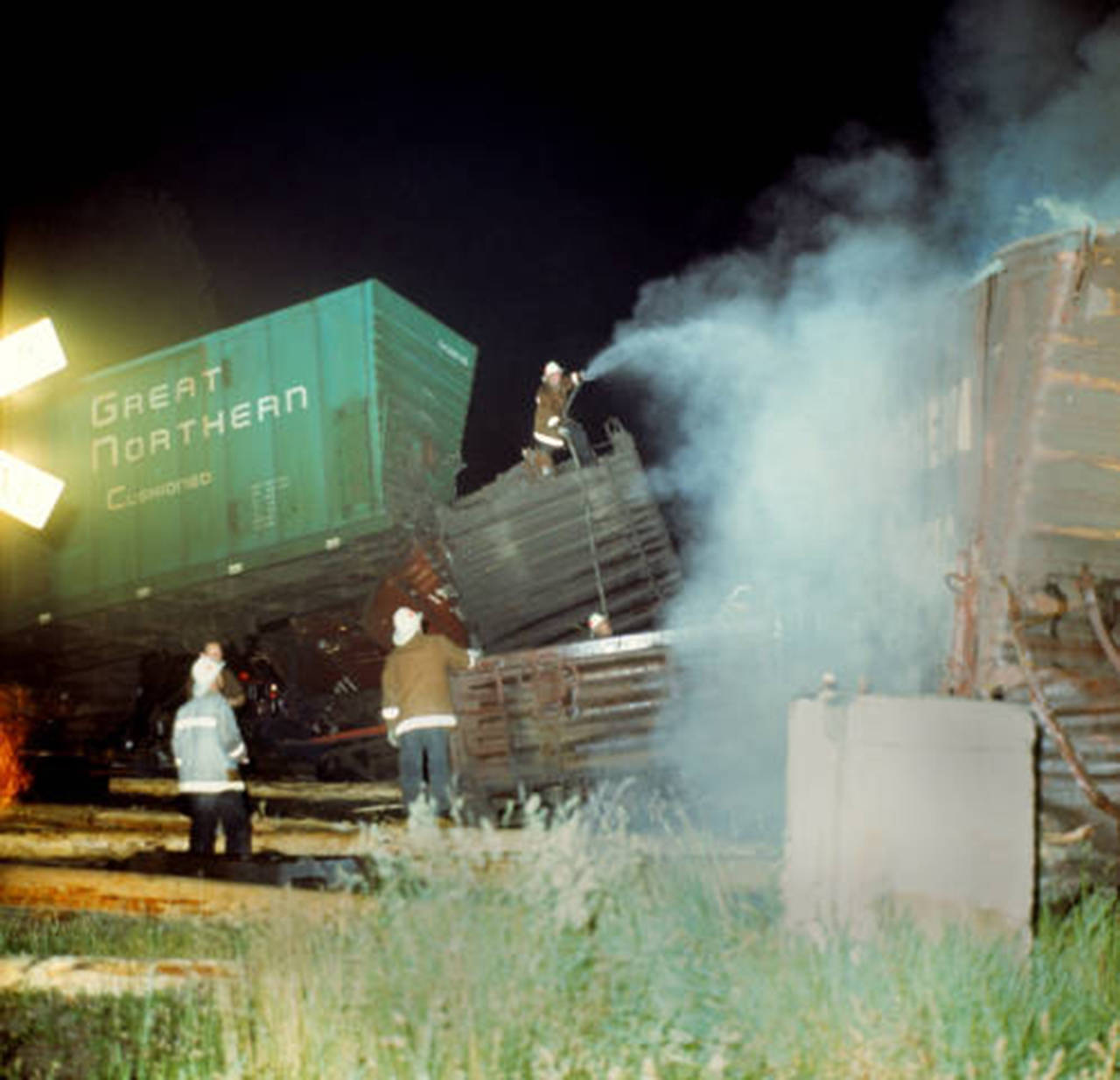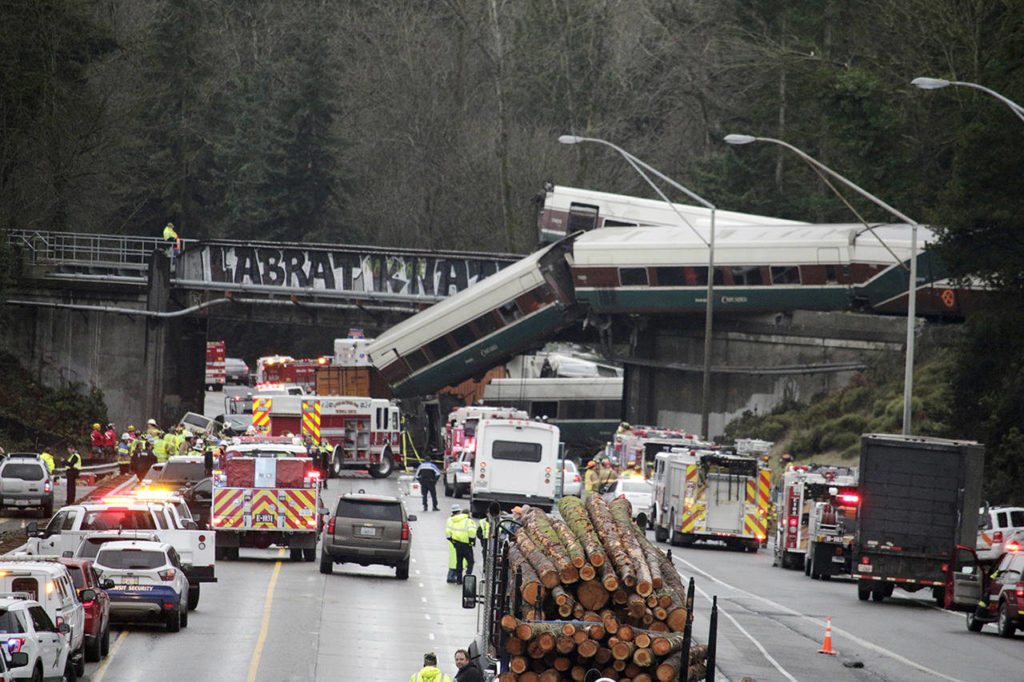EVERETT — Amtrak service from Seattle to points north and east continued after Monday’s fatal derailment onto I-5 south of Tacoma.
While travel remained on schedule to Canada, anyone headed south of Tacoma, by rail or road, faced major detours. The tragedy also gave pause to officials pondering wider safety concerns along the state’s rail corridors.
Sound Transit reported no disruptions for its Sounder commuter trains serving Seattle to Everett.
“Like everyone else, we’re deeply concerned and waiting to learn what caused this tragedy,” said state Sen. Steve Hobbs, D-Lake Stevens. “The Legislature stands ready to do whatever necessary to help the people and communities impacted.”
As chairman of the state Senate Transportation Committee, Hobbs has a keen interest in what caused the massive derailment.
Monday’s crash shut down southbound I-5 in the DuPont area south of Tacoma. The Washington State Patrol expected the closure to last into Monday evening, and likely longer. Northbound I-5 traffic was flowing through the area. At least three people were reported killed.
Amtrak Cascades trains 504 and 509 were canceled, without alternate transportation options. It was unclear if the service would resume on another route.
BNSF Railway freight operations, which use a different track, continued.
The National Transportation Safety Board investigation was just beginning Monday.
Though immediate effects on Snohomish County appeared to be minimal, officials from this area are bound to play important roles as more becomes known.
The tracks where the crash occurred are known as the Point Defiance Bypass and are owned by Sound Transit. Snohomish County Executive Dave Somers serves as the regional transit agency’s board chairman and had been in contact with its CEO, Peter Rogoff.
“We’re under the same regulation and oversight that all railroads are,” Somers said. “At this point, we don’t know what happened.”
Keith Millhouse, a rail-safety expert from California, said investigators will look into possible human and mechanical errors, as well as any environmental influences such as debris on the tracks.
Investigations can last up to 18 months.
Millhouse previously served as a chairman on a board that oversees a regional rail system in Southern California. He led the agency after a commuter and freight train collided in Los Angeles, killing 25 people and hurting dozens more. The engineer on board had been texting at the time of the 2008 crash.
Some trains are equipped with cameras that record operators, which could be useful evidence in investigations, Millhouse said. Amtrak trains do not have these, he said.
Video footage and eyewitness accounts suggest the train that crashed Monday might have been traveling faster than cars on the freeway.
“One of the preliminary questions I have is why the train was going the speed that it was on that curve,” Millhouse said. “A train should not be going at that speed heading into a curve like that.”
Amtrak has installed “positive train control” equipment in some of its locomotives, which can slow a train that is traveling too quickly. The agency expected to implement the technology on an additional 310 trains by December 2018, according to a September Amtrak press release. It was unclear whether the train involved in Monday’s derailment had this equipment.
Traveling by train, statistically, is far safer than driving, Millhouse said.
Passenger, freight and commuter trains zip through many communities in Snohomish County each day.
Local stations used by Amtrak Cascades include Everett, Edmonds and Stanwood.
Amtrak makes two daily round trips from Seattle to Vancouver, British Columbia. In 2017, its ridership has included 31,081 passengers from the Edmonds station, 41,783 from Everett and 5,172 from Stanwood, according to a company fact sheet.
The stops are part of the Amtrak Cascades route, which extends south to Eugene, Oregon. Washington and Oregon’s state transportation departments jointly manage the service and pay Amtrak to run it.
With more than 810,000 riders this year, “the Amtrak Cascades is the eighth most heavily traveled corridor in the country and often viewed as a model partnership among two states, a Canadian province, Amtrak, freight railroads, a commuter railroad and local communities,” the company fact sheet said.
Of all the trains traveling through Snohomish County over the past five years, seven have derailed, according to the Federal Railroad Administration. One of those derailments resulted in injuries.
More than half of those wrecks were caused by mud, snow or gravel blocking the tracks. They resulted in more than $960,000 in damage. Other recent derailments were attributed to human error, such as traveling too fast, or problems with the railroad.
One of those derailments involved an Amtrak train traveling from Chicago to Seattle in April 2013. It was hit by a mudslide near Howarth Park in Everett. The last three passenger cars were derailed. Although they tilted, they remained upright. No injuries were reported among the 86 passengers and 11 crew members that Sunday morning.
In 1969, two train crew members were killed and two others injured in a rear-end collision between Great Northern Railway freight trains in Marysville.
In 1981, 24 cars of a Burlington Northern freight train hauling potentially explosive liquid chlorine and propane derailed in a residential area near Marysville, forcing 5,000 people from their homes.
Although no leakage was detected from five overturned cars, county officials evacuated residents up to two miles from the accident scene.
Eric Stevick contributed to this report.
Noah Haglund: 425-339-3465; nhaglund@herald net.com. Twitter: @NWhaglund.
Talk to us
> Give us your news tips.
> Send us a letter to the editor.
> More Herald contact information.


























